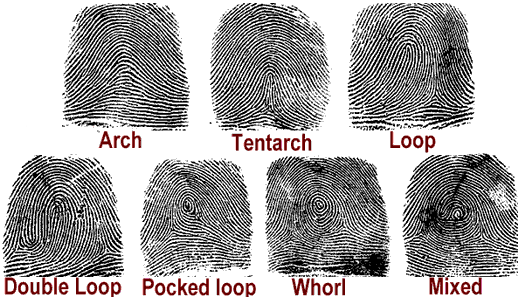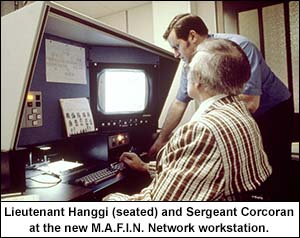Origin of Finger Prints, What They Are and How Used
by
Edward J. "Ed" Steenberg, Saint Paul Police Historical Society
The primary source of this composition is the "Souvenir Book, St. Paul Police Benevolent Association, 1919", a publication found on the SPPHS Website, although additional information and graphics have been added as appropriate.

During the last few years numerous articles have been written relative to the identification of individuals, principally criminals, by the method known as "The Finger Print System." The finger prints were first adopted as a means of identification, under a system of classification whereby a print could be filed and readily found. The subject was treated as a science and made to appear technical and difficult. This was done to keep it confidential for police purposes.
ORIGIN
According to the record of researches by prominent criminologists, the individuality of the finger print, better known as the thumb print, and its value in proving identity, was discovered by the Chinese over 200 years before the Christian era, an impression of the thumb being used by them in place of a signature in all legal and business transactions; later this method was also adopted in India, and while from time to time various systems for the classification of impressions were advanced, they were not considered until the English government, realizing its value, adopted the "Henry System" in 1901. Since then the finger prints have been installed by the police departments of all the principal cities throughout the world.
WHAT AN IMPRESSION OR FINGER PRINT MEANS
The term "finger print" or "impression," means the reproduction of the ridge formation on the bulb surface of the outer or nail joint of the finger in any manner whatever, whether it be made with ink, blood, or the greasy substance which is emitted by the sweat glands.
CLASSIFICATION OF IMPRESSIONS
There are various systems for the classification of finger prints, however, the Henry System is the one that has been made universal. The finger prints are based upon the peculiarities of the ridges, such as the formation into various patterns by which the primary classification is determined, and by the formation of two fixed points known as the Core or Inner Terminus, and Delta, or Outer Terminus, together with the ridges intervening and surrounding these two points, by which the sub-classification and in some cases, the final classification is determined.
The impressions are divided into two groups. The first group consists of patterns which have no numerical value, viz., loops, arches and tented arches. The second group consists of patterns having a numerical value in accordance with their position in a set of prints, viz., whirls and composites which include Central Pocket Loops, Laternal Pocket Loops, Twined Loops, and Accidentals. The ten fingers are divided into five pairs. After a set of impressions are classified they are filed according to the classification obtained, which is in the form of a fraction, for example 5-16; this signifies that the card is filed in the 16th drawer, and in the fifth file in the drawer; the drawers of the cabinet are marked 1-1 to 32-32.
HOW USED
Finger prints are used in Police Departments for identifying persons who may have a previous criminal record; it also aids the Police in apprehending and identifying criminals who unconsciously leave their impressions on some article at the scene of a crime. These impressions are doctored up by means of chemical powders, photographed, and are very often submitted as the only evidence of guilt. When impressions of three or four fingers are left unconsciously, a classification is possible, by considering each of the missing fingers under both groups of patterns; but where the impression is of one finger, this is not possible, as no system has been devised where a classification is possible, and thee is no method to determine which one of the ten fingers it might be.
When identifications are made of one impression it is usually done in one of two ways: either by comparing the print with those on file of persons suspected of a crime, or by the arrest of some person charged with the crime, in which place the finger prints are taken and a comparison make. If no identification should be made at the time under either of the preceding circumstances, the impression is preserved for future use.
The St. Paul Police Department inaugurated the finger print system in October, 1917, in connection with the Bertillion System, the latter system having been used by the Department for over twenty years. At the present time there are between 2,500 and 3,000 finger prints on file, and 75,000 Bertillion records and photos.
For additional information on the Bertillion System for identification of criminals, go to "History of the Police and Fire Departments of the Twin Cities, 1899", a publication found on the SPPHS Website.
A set of finger print impressions of every person taken at the local bureau is sent to the United States Government Bureau of Criminal Identification at Leavenworth, Kansas. This is done by all the principal departments throughout the United States.
The previous information was taken from a 1919 publication. What do you think they would have thought about the state-of-the-art technology that came about in 1979? That was the year that the department, along with the B.C.A. and Minneapolis Police Department became the first in the nation to join forces in the creation of an automated fingerprint identification network, called the Minnesota Automated Fingerprint Identification Network (MAFIN). This network enabled fingerprint examiners to enter fingerprints from crime scenes into a database containing fingerprints of all arrested persons in Minnesota, including juveniles from Minneapolis and Saint Paul. A positive search resulted in a hit, indicting that the suspect had been identified through fingerprint records previously on file. This cooperative effort was brought to the Department through the hard work of Lieutenant Gerald A. Hanggi1 and Sergeant Joseph K. Corcoran2.

That first fingerprint computer filled up an entire room at the department. By the time the network was turned over to the B.C.A. it had grown to include the entire state of Minnesota as well as most of North and South Dakota. The network had grown in size, but technology had allowed the computer hardware to reduce its dimensions to not much greater than many of today's home entertainment centers. Today, MAFIN stands for the Midwest Automated Fingerprint Identification Network, with Minnesota continuing to host the regional database.
If the introduction of fingerprint analysis revolutionized the identification of criminals in the early 1900s, the introduction of MAFIN in 1979 made it more useful as a crime fighting tool. And then in 1988 the Saint Paul Police Department led the way in fingerprint technology when the department received a novel "inkless" fingerprint system (Digital Biometrics) which used sophisticated cameras to capture the prints' image. A printer then created a hard copy of the fingerprint. Only one other metropolitan agency had this technology at the time. Oh have we changed!
1 Gerald A. Hanggi was appointed dPatrolman on July 6, 1948; was promoted to Detective on august 10, 1957; was promoted to Lieutenant on January 11, 1973; and retired for pension on February 16, 1990.
2 Joseph K. Corcoran was appointed Patrolman on March 2, 1964; was promoted to Sergeant on October 3, 1970; was promoted to Lieutenant on March 24, 1990; and retired for pension on March 27, 1998.
